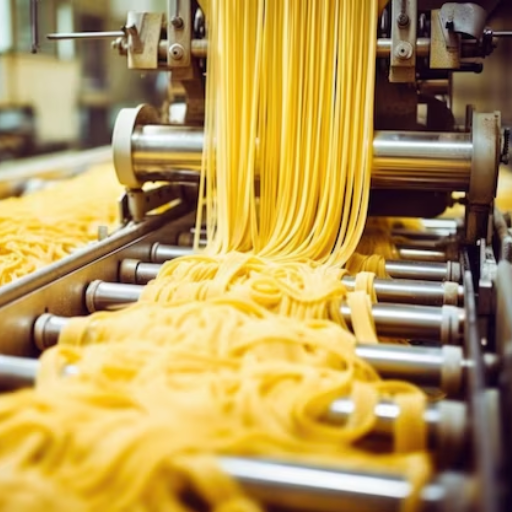Working as quickly as possible in the fast food industry is essential. This means that everything should be done in a way that takes the least time and effort. This article looks at some ways to make your spaghetti production line faster so that you can keep up with other companies. Throughout this piece, we will cover all areas of optimization, from staff training programs to workflow management systems and adoption of advanced technologies, thus providing comprehensive guidelines for improving efficiency in spaghetti manufacturing, whether you are experienced or just starting in this field.
What Are the Key Components of a Spaghetti Production Line?

Image source: https://www.youtube.com/
A spaghetti manufacturing line comprises different essential parts that coordinate to ensure effective production. These are:
- Storage and handling of ingredients: This area involves the appropriate storage of flour and water, among other necessary components, with devices for easy movement to the mixing point.
- Mixing and kneading machines: After storage, ingredients are mixed using industrial mixers, which help achieve uniform dough. This is followed by kneading devices, which develop gluten structure within the dough.
- Extrusion machines: The kneaded dough is then placed into extrusion machines, where it takes shape as the desired spaghetti. Different pasta shapes can be obtained since various dies are available.
- Drying equipment: Spaghetti must be dried after extrusion to reduce moisture content; this is done using special dryers that ensure the quality of pasta is maintained, and spoilage is prevented.
- Cutting and packaging station: Ultimately, dried spaghetti is cut into required sizes before being packed with protective materials for freshness during storage and transportation.
When these units are combined, manufacturers can achieve a smooth flow of activities along the production line, thus enhancing efficiency and product standards.
Essential Machinery in a Production Line
Efficiency in a spaghetti production line can only be achieved by ensuring that some machines are always present. Some of the types of machines needed are:
- Industrial mixers are essential as they help ensure that ingredients are mixed evenly. Some advanced models have programmable features that can help adjust the time and speed of mixing depending on specific recipe requirements.
- Extruders: These machines shape dough into spaghetti; they work by pushing it through a die, allowing for the rapid production of different pasta shapes and sizes.
- Dryers: The right drying equipment should be used to lower the moisture content of extruded spaghetti, which prevents it from rotting and increases its shelf life. Most modern dryers have systems that optimize airflow and temperature, thus preserving the texture and quality of pasta.
- Packaging Machines: Spaghetti is packed after drying using automated packaging machines, which seal it inside moisture-resistant materials, thereby keeping it fresher longer and increasing convenience for consumers.
Thus, when all these devices are integrated within an efficient production chain, they do not only enhance operational effectiveness but also ensure good standards of product quality are upheld throughout.
Role of Mixers in Spaghetti Processing
In spaghetti manufacturing, mixers are essential since they ensure that all ingredients are mixed uniformly and that the dough is consistently made. Mixing involves combining flour with water and other components necessary for obtaining the required texture and elasticity of the dough. A good quality industrial mixer mixes everything well and allows producers to manage parameters such as speed and time that may be adjusted according to particular recipes. It is necessary to keep precision in mind because the consistency of the correct dough greatly influences cooking properties (firmness, cooking period, etc.), affecting final product quality, too. Besides this, if done correctly, mixing can save time spent on production, thus increasing overall spaghetti-making efficiency, which makes it an indispensable part of any successful line.
Significance of Extruder Process in Production
The extruder is very important in spaghetti production because it decides the final product’s shape and texture. During extrusion, a mixture of doughs is pushed through a die that cooks them under high temperatures and pressures while giving them their spaghetti-like strands. In addition to strengthening pasta firmness and elasticity, this method ensures even cooking times throughout every batch, thus resulting in uniformly good quality spaghetti each time. Additionally, these machines have the capability of introducing different elements like vitamins or alternative flours, which makers can use for innovation purposes as well as meeting various customer needs. Generally speaking, then, not only does an extruder help optimize efficiency in production, but it also cuts down on waste produced while at the same time enhancing stability levels for finished goods on shelves.
How to Choose the Best Pasta Production Line Equipment?
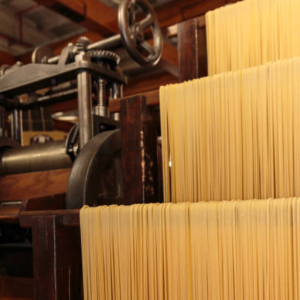
Choosing the right pasta production line equipment has many factors to put in mind. Start by determining the amount of production you need so that it can match with your market demand and also ensure that whatever machine you choose can be scalable with your operations. Then again consider quality and type of ingredients intended for use; this will determine what features and specifications are necessary mainly in mixers as well as extruders. Equally important is how much automation is required since modern systems have ability to greatly improve efficiency while at the same time cutting down on labour cost. Moreover assess ease of maintenance for these machines, availability of spare parts, support services from manufacturers among others which help in reducing downtime. Finally read through feedback given by customers who have used different brands or models before making comparisons based on technical requirement alone but also considering budget versus production target.
Factors to Consider in Equipment Selection
When you are selecting the pasta production line equipment, remember what industry experts say and keep in mind these few things:
- Production Volume and Efficiency: The first thing to do is check if this machine can handle your required amount of products. You should choose those which provide high throughput rates without sacrificing quality as it helps meet market needs faster.
- Ingredient Compatibility: Ensure its adaptability with different ingredients because versatility is key when dealing with various types of pastas or following current fashions among consumers.
- Automation and Control Systems: More automated systems mean less time wasted on manual labor thus improving overall productivity levels within any given period. Such machines can also monitor processes better through their advanced control mechanisms leading to increased uniformity and reduced wastage during production.
- Maintenance and Service Support: What matters most here is how easy one can access spare parts for replacement purposes coupled with routine maintenance practices offered by manufacturers at large. Smooth running operations require minimal downtime therefore opt for post-sale services that assist in achieving this objective.
- Cost-effectiveness: This may sound obvious but many people tend to overlook it when making purchases; however, consider not only initial costs but also long-term operational savings achievable through acquiring an efficient system which lasts longer while still meeting required standards – such units will be more economical over a period of time.
Evaluate all of the above mentioned considerations and you will have selected the right pasta production line equipment suitable for your business objectives as well as capabilities in no time.
Top Manufacturers in Pasta Production
When it comes to exploring the pasta product manufacturers, three companies are frequently recognized as the leaders of this industry:
- Bühler Group: This company is well-known for offering food processing solutions that are packed with innovation. They provide pasta manufacturing technology that is up-to-date and efficient. The machines can produce different shapes and sizes of pasta.
- Pavan Group: Pavan group has solid reputation within the pasta industry sector where they offer full-service engineering solutions including machines and complete production lines. Their systems are designed to be automated so as to save energy while maximizing on quality which also helps in meeting high standards at lower costs towards optimal productions.
- Fava S.p.A.: As a major player among other companies involved in making pastas, Fava specializes mainly on designing and producing equipments meant for traditional or even modern types of pastas. They always strive to bring about new ideas thereby becoming more innovative than any other similar business thus their reliability when it comes finding suitable machinery for different needs by producers who make noodles.
Thus looking at these best manufacturers will enable businesses access sophisticated equipment that improves their production capacities and meets customer preferences.
Comparing Automatic vs. Manual Production Line
When selecting among automatic and manual pasta production lines, it’s important to consider each one’s specific advantages and disadvantages.
Automatic Production Lines: These systems are created in such a way that they make the manufacturing process easier by eliminating most of the manual jobs thereby making them more efficient. Continuous running is possible with this type of line hence higher quantities can be produced within a set time while keeping quality constant throughout. Also, they have sophisticated technology which allows accurate control over many different production parameters leading to less wastage as well as saving energy since all operations are performed mechanically or electronically. Nonetheless, initial investments required for automation traditionally run high plus continuous servicing may need skilled personnel.
Manual Production Lines: While manual lines may involve a more hands-on approach and possibly lower initial costs, they often require a larger workforce and may be more labour-intensive. For producers who specialize in artisanal pasta varieties, being able to change production processes without significant equipment modifications is an important benefit. However, this flexibility also reduces efficiency thereby limiting scalability which makes meeting large-scale demand difficult.
In conclusion, choosing between automated or non-automated production lines relies on specific needs of the company concerned together with its budgetary limits as well as volume of output expected from it over time. Each alternative has some benefits not found in others but which can be used strategically by different businesses operating within the pasta making industry.
What Are the Steps for Processing Fresh Pasta?

To make fresh pasta, there are a few steps you need to take in order for the final product to meet quality standards.
- Preparation: To start with, measure out your flour and eggs (these are typical ingredients but you can use whatever you like). Just make sure that the flour is suitable for making pasta so that it has a nice texture.
- Mixing the dough: Next up is mixing everything together until it forms into one lump of dough. You might have to knead this by hand or use an automatic mixer if you want uniformity.
- Allowing the dough to rest: Then let it sit for at least half an hour – an hour would be even better. This gives time for the gluten strands in the dough to relax which will make rolling easier later on.
- Rolling and shaping: After resting, roll out some sheets of pasta using either a pasta machine or just a regular old rolling pin. Cut these into what ever shape you’re feeling – fettuccine strips, lasagna sheets or stuffed shapes all work!
- Cooking: Once your pasta’s made simply boil it in salted water. Fresh stuff only needs 2-4 minutes depending on how thick it is.
-
Serving: Drain off any excess water then serve up straight away with sauce or toppings of your choice. Fresh pasta has such a different texture and taste compared with dried; both are great but go well with different things.
These steps lead to deliciously textured fresh pastas through which producers can make themselves known for their exceptional taste.
Step-by-Step Guide to Fresh Pasta Manufacturing
In order to further enhance the production process of fresh pasta, here are some clear insights on how it should be done:
- Choose Quality Ingredients: The best flour for this job would be either ‘00’ flour or semolina because they give off perfect texture. Fresh eggs are preferred too, and they should be at room temperature so that they can blend easily with the dough.
- Employ Correct Mixing Techniques: Thoroughly mix everything together using either a stand mixer fitted with dough hook or simply your hands on a clean surface; whichever works best for you. What matters is that there should be no lumps left in the mixture and it must have consistent moisture content throughout.
- Knead Properly: Take anywhere from eight minutes up to ten minutes kneading until smoothness sets in then stop. This stage cannot be overemphasized since gluten development takes place here which gives pasta its shape.
- Rest and Relax: After kneading wrap the dough in plastic foil for about thirty minutes minimum but an hour maximum is recommended so that gluten may rest hence making it easier when time comes to roll.
- Rolling and Shaping with Accuracy: Achieving uniform thickness can only be possible if one uses pasta machine otherwise rolling pin will also do fine especially those who prefer traditional methods. Shape them as desired keeping size consistent all round which enables even cooking process.
- Watch Cooking Time: Always cook fresh pastas under close supervision unlike dried ones; this is because they tend to become ready much quicker than expected. To achieve desired al dente texture keep testing continuously until ideal doneness point is reached.
- Matching and Serving: Select sauces that will not overpower delicate flavors of fresh pasta but rather complement them then serve straight away so as not lose out on any taste perception.
By following this perfected step by step guide, manufacturers will improve their fresh pasta products while meeting demands from choosy customers.
Importance of Proper Cooling and Packaging
It is important to cool and package fresh pasta properly in order for it to have a long shelf life. As per the observations of the experts, cooling down the freshly cooked pasta quickly helps to hinder bacterial growth while maintaining its desired texture. Also, moisture is retained in well cooled pastas which makes them taste fresher when eaten. Furthermore, packaging should be done rightly so as to shield the pasta from such external elements as light, air and moisture all which can cause rotting. In addition, using air tight packages made of food grade materials not only preserves quality but also enhances durability thus improving on consumers’ satisfaction levels. Manufacturers who prioritize these procedures will be able to provide safer products that meet the expectations of buyers in terms of safety and excellence.
How to Increase Production Output in Your Spaghetti Production Line?
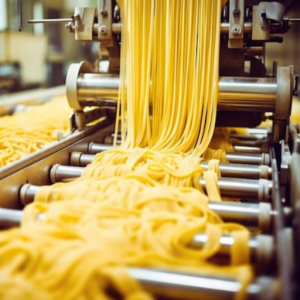
To produce more spaghetti in a production line you need to streamline processes, invest in automation and enhance training of workforce.
- Simplify processes: look at every stage of production so as to identify where the problem may be. Use lean manufacturing techniques to reduce wastage and ensure smooth flow of activities.
- Automate: One can upgrade their machines which will be able to carry out tasks much faster than before. Dough mixers with big capacities, continuous pasta extruders among others are some examples of such machines; they will cut down on manual work and increase uniformity.
- Give better training: If employees are taught how best operate new technologies then they might become more productive. In addition, this move can also help them know what is required when using machines for quality purposes.
- Maintenance: It is important that companies organize regular maintenance services for machines so that they do not break down often hence leading to low output. Besides that, a machine which has been maintained well tends to work faster thus producing many items within the same period.
- Quality control monitoring: The systems put in place should be able catch any faults without necessitating redoing of the whole process again if it fails these standards. Real time tracking helps detect where there could have been a problem with quality quickly thus enabling rectification.
If manufacturers pay attention to these areas; they can achieve high volumes while ensuring quality levels are not compromised during spaghetti manufacture.
Optimizing Processing Line for Higher Output
To better output of a spaghetti manufacturing system, there are various methods that can be employed by the producers.
- Designing the Workflow: An efficient layout which reduces movement between stations is considered key in this regard by industry experts. Sometimes this may mean rearranging equipment so that it follows the process flow thus ensuring smooth transition from one phase of production to another.
- Use of Data Analytics: Monitoring production metrics as well as identifying areas for improvement can be done through data analytics. Inefficiencies should be highlighted through implementation of software that tracks machine performance and rates of production then operational adjustments guided accordingly.
- Employee Involvement: Some sources also stress on engaging workers when carrying out these changes. Staff feedback brings about practical solutions while motivating them towards adopting new practices.
It is possible for businesses to attain higher outputs while maintaining quality products along their spaghetti manufacture lines if they concentrate on such optimized workflows, employ technology and involve the workforce.
Innovative Solutions to Boost Production Capacity
To improve spaghetti production lines for higher production capacity, there are several innovative solutions that can be considered by the makers. Here are some of them:
- Technology of automation: When they put automated machinery and robotics in place, they will greatly enhance processing speed while minimizing mistakes made by humans. For example, mixing, cooking and packaging can all be done through automation thus not only does it speed up production but also ensures uniform quality.
- Flexible Manufacturing Systems (FMS): Manufacturers should install FMS so as to enable quick changeover between products or batch sizes without long idle periods on the line. This makes it possible for businesses to respond promptly to market requirements hence reducing wasted resources.
- Sustainable practices: Sustainable production methods increase output besides being in line with consumer demand for environmentally friendly goods. Utilization of energy saving devices and recycling materials during manufacturing process can result into cost savings as well as reduced ecological footprints.
By incorporating these state-of-the-art solutions, producers can maximize their productivity levels while maintaining high standards of quality assurance and promoting sustainable development goals at large.
Tips for Scaling Up Your Production Line
When you want to increase the size of your spaghetti production line, try out these things:
- Making Decisions Based on Data: Use analytics for tracking the production processes as well as finding the places where it is slow. Manufacturers can make better choices about what to do based on this information so that they can optimize their operations and become more efficient.
- Train Employees Well: You should have a highly skilled workforce if at all you want maximum effectiveness from your production lines. There should be regular sessions for training employees which can help improve their technical abilities thus enabling them work with new technologies while still maintaining high standards of output.
- Keep Machines in Good Condition All The Time: It is necessary to carry out regular checkups on all equipment so as not only to avert inefficiency caused by breakdowns but also keep them running smoothly always. A reliable production line always supports higher output therefore this should be done without fail.
Following these guidelines will enable manufacturers scale up their production lines effectively without compromising quality or engagement among workers.
Where To Buy Production Line Equipment for Spaghetti Production?
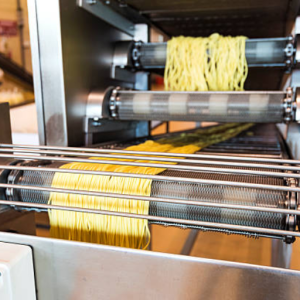
To produce spaghetti the producers should find where to purchase production line equipment, which implies checking with various food processing machinery suppliers. Below are some of them:
- Alfa-Laval: This company is well known for its creative methods of separating substances mixed together as well as transferring heat between two or more fluids at different temperatures. They have a variety of devices that can be used during pasta making.
- Pavan Group: Being among the world leaders in manufacturing machines designed specifically for processing different types of pastas; they offer their customers complete solutions needed along spaghetti production lines.
- M.G. S.r.l.: The company boasts having unique pasta machines which are tailored according to each customer’s specifications hence they focus more on design flexibility than any other thing while building such equipment.
- Reiser: Its range includes sophisticated components required by a food processor who wants everything automated including making noodles from scratch up till packaging them ready for sale so this would suit someone looking forward to starting an industrial scale pasta factory.
- Local Distributors: People usually forget about local suppliers thinking that there might not be anything good they offer but truth is these guys can provide you with personalized attention plus support besides giving access to specific items too; just check if there’s any around your area otherwise try looking out for those located near regions known for manufacturing such machinery because sometimes even small companies may have unique options which big ones don’t possess.
With all these points considered, one will definitely get suitable supplies needed during their spaghetti production process.
How to Use Alibaba.com for Machine Purchases
When buying a spaghetti-making machine on Alibaba.com, consider these tips for success:
- Register: Join the website so that you can deal with more suppliers and use more services. This is also where you can save items and talk directly with sellers.
- Search for machinery: Some good keywords are “spaghetti production machines” or “pasta making equipment.” You may also want to filter results by supplier type (e.g., Gold Supplier), customer ratings, and product certifications.
- Review sellers: Read through their product descriptions, reviews from customers, and ratings. Look at how quickly they respond to inquiries and their transaction history over time.
- Contact vendors: Ask the seller about their equipment’s pricing, lead times, any additional fees such as shipping costs. You should also request for quotes along with detailed specifications in form of brochures if available.
- Bargain on terms: On Alibaba.com you can negotiate your price directly with the supplier – just make sure it is clear what exactly you need from them beforehand! Don’t be afraid to haggle either!
- Check Quality Assurance: The authenticity of a product can be verified by requesting samples prior purchase. Additionally, warranties; return policy; after sales support etcetera should not be left out during inquiry stage so that one is assured of getting value for money spent in acquiring goods or services.
- Place an Order: Once you have found a trustworthy seller through whom your order shall be placed via Alibaba’s secure payment methods; trade assurance being one of them which provides more security against fraudsters most especially when dealing with large sums of money at once.
By doing this manufacturers will get the best out of Alibaba.com while purchasing right machines which will improve their spaghetti production lines.
How to Maintain and Troubleshoot Your Spaghetti Production Line?
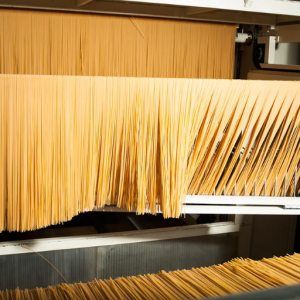
To keep a spaghetti-making machine running at full capacity, you must regularly check it out and take preventative action when necessary. One way to do this is by cleaning the equipment on a regular basis; this prevents flour and other materials from building up which can affect the quality of the noodles produced. Checking belts, bearings or blades for wear-and-tear should be done frequently so as not to have these parts unexpectedly break down during use. Another step in maintaining an efficient spaghetti production line involves making sure that all settings and calibrations on machines are aligned with what is needed for production.
If troubleshooting becomes necessary: In order to fix any problems that may arise while making pasta with such a system we need first identify where things went wrong within our process; were there any inconsistencies noticed regarding thickness levels? Maybe cooking times were irregular? The manual should then be consulted for specific steps related to each type of equipment being used in order fix this problem. If it still persists after following these instructions then contacting either technical support from manufacturer themselves or someone who specializes specifically with pasta machinery would prove helpful. Writing down causes along side their respective fixes will enable us create more effective routines for carrying out maintenance which leads ultimately towards having smoother operations over time.
Regular Maintenance Tips for Spaghetti Machines
- Daily Cleaning: Flour and starches should be removed from the spaghetti machine by cleaning all areas at the close of each day’s production because this may cause mechanical breakdowns and reduce the quality of the end product.
- Lubrication: Apply oil regularly on moving parts as directed by the manufacturer to minimize friction between them hence reducing wearing off thus lengthening its lifespan.
- Calibration Checks: Check calibration settings frequently enough according to what is recommended by manufacturers so that thicknesses of noodles produced remain constant throughout cooking times too.
- Inspect Wear Components: Prevent unexpected downtimes by often examining replaceable elements that wear out quickly including belts among others.
- Record Maintenance Activities: A detailed record involving maintenance work carried out needs to be kept which should cover cleaning exercises undertaken, inspection points covered as well as parts replaced during such events so as to plan for future maintenance programs better while troubleshooting effectively.
These tips for maintenance will enable you have a reliable and effective spaghetti making line; thus increasing productivity levels besides improving quality standards.
Common Issues and Solutions in Pasta Production Lines
- Dough Consistency Problems: One problem common to pasta production is differing dough texture resulting from changes in flour quality and incorrect water-to-flour ratios. To correct this, carry out frequent assessments of the quality of flour used as well as accuracy in measurement during mixing. The use of a standardized recipe can also help minimize such variations.
- Machine Jamming: It so happens sometimes that machines get jammed when residues accumulate within them or parts become worn-out. In order to fix it, you should do regular check-ups and cleanings especially around areas where there’s a tendency to leave behind dirt. If jamming continues happening, then belts’ integrity and rollers’ conditions should be verified for proper functioning.
- Fluctuating Production Speeds: Mechanical faults or wrong machine settings could cause uneven production speeds. To solve this problem, lubricate moving parts well during scheduled maintenance checks while ensuring none is blocked by any objects. For stability in operation it may also require resetting machine parameters frequently following manufacturer’s instructions on recalibration.
These suggestions together with routine servicing will greatly enhance efficiency as well as reliability levels along pasta manufacturing lines.
Frequently Asked Questions (FAQs)
Q: What are the key components of a spaghetti pasta production line?
A: The key components of a spaghetti pasta production line include the semolina mixing tank, dough kneader, extruder process manufacture machine production, drying chambers, and cutting stations. Each piece of equipment plays a vital role in ensuring the efficient production of spaghetti pasta.
Q: How do I select the best production line equipment for cooking spaghetti pasta?
A: When selecting production line equipment for cooking spaghetti pasta, consider factors such as production capacity, machine durability, ease of maintenance, and the reputation of the manufacturer. Look for equipment made of stainless steel, which is known for its longevity and easy cleaning.
Q: What are the benefits of using a fresh pasta production line versus dry pasta lines?
A: Fresh pasta production lines offer the advantage of producing pasta with a softer texture and richer flavor compared to dry pasta lines. Fresh pasta lines are ideal for producing a variety of short and long cut pasta shapes, catering to gourmet markets and local consumption.
Q: How can I minimize downtime in my spaghetti production line?
A: To minimize downtime in your spaghetti production line, ensure regular maintenance of all machines, keep an inventory of essential spare parts like screws and panels, and train staff to handle minor repairs promptly. Investing in high-quality equipment from reliable manufacturers can also reduce the frequency of breakdowns.
Q: What is the role of the extruder process manufacture machine production line in spaghetti production?
A: The extruder process manufacture machine production line is crucial for shaping the dough into spaghetti pasta. It uses high pressure to push the dough through dies, creating long strands of spaghetti that are then cut to the desired length and dried.
Q: How can I improve the efficiency of my dry pasta lines?
A: To improve the efficiency of dry pasta lines, optimize the drying process to balance drying time and energy consumption, use high-quality raw materials such as semolina flour, and ensure that the pasta shapes do not stick together during drying. Regular calibration of machinery can also lead to more consistent production.
Q: What are the common challenges in fresh pasta production lines?
A: Common challenges in fresh pasta production lines include maintaining consistent dough texture, preventing pasta from sticking during the production process, and ensuring the product has a suitable shelf life. Using high-quality flour and maintaining strict hygiene standards can help mitigate these issues.
Q: How can I ensure fast delivery to Australia for my spaghetti pasta products?
A: To ensure fast delivery to Australia, establish a reliable logistics network, work with experienced freight forwarders, and plan your inventory management to avoid stockouts. Partnering with a distributor that understands the local market can also improve delivery times and customer satisfaction.
Q: What factors should I consider when purchasing a machine within Canada?
A: When purchasing a machine within Canada, consider factors such as compliance with local regulations, availability of technical support and spare parts, and the reputation of the supplier. Request demos and trials to validate the machine’s performance before making a purchase.












